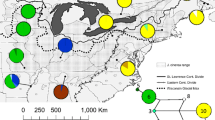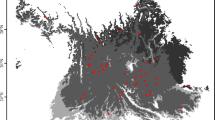Abstract
In order to elucidate the past distribution and colonization routes of broad-leaved evergreen (lucidophyllous) forests, we investigated the intraspecific phylogeographic patterns of lucidophyllous forests in Japan and surrounding areas. We selected 6 component species with a similar geographic distributions growing in Castanopsis-dominant forests. We defined possible important refugia during the glacial periods as the regions rich in rare haplotypes (with a frequency of 5% or less), or as regions rich in the number of common haplotypes (with a frequency of more than 5%). We then located the sites of refuge by comparing the intraspecific phylogeographic patterns among 6 component species of lucidophyllous forests with respect to these two parameters (i.e., haplotype uniqueness and the number of haplotypes). The following results were obtained during the course of this study: (1) rare haplotypes were distributed among islands around the main islands of Japan; (2) rare subtypes and the greatest numbers of common haplotypes were observed in Kyushu, a finding which agreed with fossilized pollen data demonstrative of the past existence of refugia in southern Kyushu; and (3) rare haplotypes were found on the Muroto Peninsula, and the second greatest numbers of common haplotypes were observed on the Kii Peninsula, a finding which suggested the existence of additional important refugia along the Pacific coast of Japan during the glacial ages.




Similar content being viewed by others
References
Aoki K, Suzuki T, Murakami N (2003) Intraspecific sequence variation of chloroplast DNA among the component species of evergreen broad-leaved forests in Japan. J Plant Res 116:337–344
Arbogast BS, Kenagy GJ (2001) Comparative phylogeography as an integrative approach to historical biogeography. J Biogeogr 28:819–825
Avise JC (1989) Gene trees and organismal histories: a phylogenetic approach to population biology. Evolution 43:1192–1208
Avise JC (1992) Molecular population structure and the biogeographic history of a regional fauna: a case history with lessons for conservation biology. Oikos 63:62–76
Avise JC (2000) Phylogeography. Harvard University Press, London
Avise JC, Arnold J, Ball RM, Bermingham E, Lamb T, Neigel JE, Reeb CA, Saunders NC (1987) Intraspecific phylogeography: the mitochondrial DNA bridge between population genetics and systematics. Annu Rev Ecol Syst 18:489–522
Chase MW, Soltis DE, Olmstead RG, Morgan D, Les DH, Mishler BD, Duvall MR, Price RA, Hills HG, Qiu Y-L, Kron KA, Rettig JH, Conti E, Palmer JD, Manhart JR, Sytsma KJ, Michaels HJ, Kress WJ, Karol KG, Clark WD, Hedrén M, Gaut BS, Jansen RK, Kim K-J, Wimpee CF, Smith JF, Furnier GR, Strauss SH, Xiang Q-Y, Plunkett GM, Soltis PS, Swensen SM, Williams SE, Gadek PA, Quinn CJ, Eguiarte LE, Golenberg E, Learn GH, Graham Jr SW, Barrett SCH, Dayanandan S, Albert VA (1993) Phylogenetics of seed plants: an analysis of nucleotide sequences from the plastid gene rbcL. Ann Mo Bot Gard 80:528–580
Chiang T-Y, Schaal BA, Peng CI (1998) Universal primers for amplification and sequencing a noncoding spacer between the atpB and rbcL genes of chloroplast DNA. Bot Bull Acad Sin (Taiwan) 39:245–250
Demesure B, Comps B, Petit RJ (1996) Chloroplast DNA phylogeography of the common beech (Fagus sylvatica L.) in Europe. Evolution 50:2515–2520
Doyle JJ, Doyle JL (1987) A rapid DNA isolation procedure for small quantities of fresh leaf material. Phytochem Bull 19:11–15
Dumolin-Lapègue S, Demesure B, Fineschi S, Le Corre V, Petit RJ (1997) Phylogeographic structure of white oaks throughout the European continent. Genetics 146:1475–1487
Ferris C, King RA, Väinölä R, Hewitt GM (1998) Chloroplast DNA recognizes three refugial sources of European oaks and suggests independent eastern and western immigrations to Finland. Heredity 80:584–593
Fujii N (2001) Research on the historical processes of Japanese flora from phylogeographical analyses using organelle DNA (in Japanese with English abstract). Proc Jpn Soc Plant Tax 15:11–17
Fujii N, Ueda K, Watano Y, Shimizu T (1997) Intraspecific sequence variation of chloroplast DNA in Pedicularis chamissonis Steven (Scrophulariaceae) and geographic structuring of the Japanese “alpine” plants. J Plant Res 110:195–207
Fujii N, Tomaru N, Okuyama K, Koike T, Mikami T, Ueda K (2002) Chloroplast DNA phylogeography of Fagus crenata (Fagaceae) in Japan. Plant Syst Evol 232:21–33
Gilbert D (1996) SeqPup version 0.6: a biological sequence editor and analysis program. Indiana University. http://iubio.bio.indiana.edu/molbio/seqpup. Cited 11 June 2003
Harris SA, Ingram R (1991) Chloroplast DNA and biosystematics: the effects of intraspecific diversity and plastid transmission. Taxon 40:393–412
Hattori T (1985) Synecological study on the lucidophyllous forest of Castanopsis-Persea type in Japan proper (in Japanese with English abstract). Bull Kobe Geobot Soc 1:1–98
Hattori T (2002) Chapter 7 (in Japanese). In: Yahara T, Kawakubo N (eds) Biology of conservation and restoration. Bun-ichi Sogo Shuppan, Tokyo, pp 203–222
Hattori T, Ishida H, Kodate S, Minamiyama N (2002) The characteristics of lucidophyllous forest flora and conditions endangering them in Japan (in Japanese with English abstract). J JIRA 65:609–614
Hewitt GM (1999) Post-glacial re-colonization of European biota. Biol J Linn Soc 68:87–112
Hewitt GM (2001) Speciation, hybrid zones and phylogeography—or seeing genes in space and time. Mol Ecol 10:537–549
Horikawa Y (1972) Atlas of the Japanese flora, vol 1. Gakken, Tokyo
Kira T (1977) A climatological interpretation of Japanese vegetation zones. In: Miyawaki A, Tüxen R (eds) Vegetation science and environmental protection. Maruzen, Tokyo, pp 21–30
Kizaki K, Oshiro I (1977) Paleogeography of the Ryukyu Islands (in Japanese with English abstract). Mar Sci Mon 9:542–549
Maeda Y (1970) Palynological study of the latest Pleistocene marine clay in the Itami area. J Geosci Osaka City Univ Ser 4 13:401–406
Maeda Y (1980) Jomon no umi to mori (in Japanese). Aoki-shobo, Tokyo, pp 149–216
Maskas SD, Cruzan MB (2000) Patterns of intraspecific diversification in the Piriqueta caroliniana complex in southeastern north America and the Bahamas. Evolution 54:815–827
Matsuoka K, Miyoshi N (1998) Chapter III-4 (in Japanese). In: Yasuda Y, Miyoshi N (eds) The illustrated vegetation history of the Japanese Archipelago. Asakura-shoten, Tokyo, pp 224–236
Matsushita M, Maeda Y, Matsumoto E, Matsushima Y (1988) Vegetation history during Holocene at Shingu on Kii Peninsula and Muroto point, South-western Japan, with special reference to development of Castanopsis forest (in Japanese with English abstract). Jpn J Ecol 38:1–8
Minato M, Ijiri S (1976) The Japanese archipelago, 3rd edn. (in Japanese). Iwanamishoten, Tokyo
Miyawaki A, Okuda S, Fujiwara K (1994) New revised edition handbook of Japanese vegetation. Shibundo, Tokyo
Miyoshi N (1998) Chapter II-7 (in Japanese). In: Yasuda Y, Miyoshi N (eds) The illustrated vegetation history of the Japanese Archipelago. Asakura-shoten, Tokyo, pp 138–149
Morita Y, Choi K, Hibino K (1998) Chapter II-4 (in Japanese). In: Yasuda Y, Miyoshi N (eds) The illustrated vegetation history of the Japanese Archipelago. Asakura-shoten, Tokyo, pp 92–102
Nakaike T (2001) A synoptical study on the fern genus Arachniodes Blume (Dryopteridaceae). J Phytogeogr Taxon 49:7–30
Nakanishi H (1996) Plant species with northbound distribution in western Kyushu, Japan: definition, composition and origin (in Japanese with English abstract). Acta Phytotax Geobot 47:113–124
Nasu T (1981) Map of vegetation during the last glacial maximum (Fig. 5, p 200) In: Kamei T, Research group for the biogeography from Würm Galacial (eds) Fauna and flora of the Japanese Islands in the last glacial time (in Japanese with English abstract). Quaternary Res 20:191–205
Nishizawa T, Watano Y (2000) Primer pairs suitable for PCR-SSCP analysis of chloroplast DNA in angiosperms. J Phytogeogr Taxon 48:63–66
Oba T (1988) Comment for sea level change (in Japanese with English abstract). Quaternary Res 26:243–250
Ohi T, Murata J (2000) Geographical variations in chloroplast DNA of Stachyurus macrocarpus Koidz. and Stachyurus praecox Sieb. et Zucc. (Stachyuraceae). Ogasawara Res 25:1–24
Okaura T, Harada K (2002) Phylogeographical structure revealed by chloroplast DNA variation in Japanese Beech (Fagus crenata Blume). Heredity 88:322–329
Palmer JD (1987) Chloroplast DNA evolution and biosystematic uses of chloroplast DNA variation. Am Nat 130:6–29
Petit RJ, Aguinagalde I, De Beaulieu J-L, Bittkau C, Brewer S, Cheddadi R, Ennos R, Fineschi S, Grivet D, Lascoux M, Mohanty A, Müller-Starck G, Demesure-Musch B, Palmé A, Martín JP, Rendell S, Vendramin GG (2003) Glacial refugia: hotspots but not melting pots of genetic diversity. Science 300:1563–1565
Rozas J, Rozas R (2000) DnaSP version 3.51: an integrated program for molecular population genetics and molecular evolution analysis. University of Barcelona. http://www.bio.ub.es/~julio/DnaSP.html. Cited 11 June 2003
Soltis DE, Soltis PS (1998) Choosing an approach and an appropriate gene for phylogenetic analysis. In: Soltis DE, Soltis PS, Doyle JJ (eds) Molecular systematics of plants. II. DNA sequencing. Kluwer, Massachusetts, pp 1–42
Soltis DE, Soltis PS, Milligan BG (1992) Intraspecific chloroplast DNA variation: systematic and phylogenetic implications. In: Soltis PS, Soltis DE, Doyle JJ (eds) Molecular systematics of plants. Chapman and Hall, New York, pp 117–150
Soltis DE, Gitzendanner MA, Strenge DD, Soltis PS (1997) Chloroplast DNA intraspecific phylogeography of plants from the Pacific Northwest of North America. Plant Syst Evol 206:353–373
Stewart JR, Lister AM (2001) Cryptic northern refugia and the origins of the modern biota. Trends Ecol Evol 16:608–613
Swofford D (1993) Phylogenetic analysis using parsimony, version 3.1. Illinois Natural History Survey, Champaign, Ill.
Taberlet P, Gielly L, Pautou G, Bouvet J (1991) Universal primers for amplification of three non-coding regions of chloroplast DNA. Plant Mol Biol 17:1105–1109
Taberlet P, Fumagalli L, Wust-Saucy A-G, Cosson J-F (1998) Comparative phylogeography and postglacial colonization routes in Europe. Mol Ecol 7:453–464
Tajima F (1983) Evolutionary relationship of DNA sequences in finite populations. Genetics 105:437–460
Tsukada M (1974) Paleoecology. II. Synthesis (in Japanese). Kyoritsu, Tokyo
Tsukada M (1984) A vegetation map in the Japanese Archipelago approximately 20,000 years B.P. (in Japanese with English abstract). Jpn J Ecol 34:203–208
Tsumura Y, Taguchi H, Suyama Y, Ohba K (1994) Geographical cline of chloroplast DNA variation in Abies mariesii. Theor Appl Genet 89:922–926
Watterson GA (1975) On the number of segregating sites in genetical models without recombination. Theor Popul Biol 7:256–276
Yatabe Y, Nishida H, Murakami N (1999) Phylogeny of Osmundaceae inferred from rbcL nucleotide sequences and comparison to the fossil evidences. J Plant Res 112:397–404
Acknowledgements
We would like to thank Dr. Tamotsu Hattori for his generous support and valuable suggestions, and in particular for providing information regarding the lucidophyllous forest collection sites. We would also like to thank Mr. Seiya Morinaga, Dr. Tsuguo Sakura, Dr. Nobuyuki Tanaka, Mr. Noritoshi Inagaki, Mr. Shungo Kariyama, Dr. Akihiro Seo, Ms. Miho Imada, Ms. Utami Makino, Ms. Yukimi Yoshida, Ms. Rika Takeuchi, Ms. Akemi Nakagoshi, and Ms. Keiko Aoki for their assistance with the collection of plant materials in Japan. We are grateful to Dr. Tzen-Yuh Chiang, Mr. Shann-Jye Moore, Mr. Ho-Ming Chang, Dr. Chang-Fu Hsieh, Ms. I-Ling Lai in Taiwan, and to Dr. Do-Soon Cho in Jeju Island for their assistance with our fieldwork outside of Japan. In addition, we would like to thank Mr. Hidenobu Funakoshi, Mr. Taku Fujita, Dr. Kayo Asami, Mr. Hiroaki Ishida, Mr. Yoshihiro Sawada, and Mr. Hiroji Akamatsu for sending plant samples. Finally, we would like to acknowledge Dr. Masayuki Takamiya for his identification of Arachniodes aristata. This study was financially supported in part by a Grant-in-Aid from the Japan Society for the Promotion of Science No. 13575012 to N.M.
Author information
Authors and Affiliations
Corresponding author
Appendices
Appendix 1
Table 6 lists voucher information regarding the plant samples.
Appendix 2
Tables 7, 8, 9, 10, 11 and 12 show aligned sequences of polymorphic sites.
Rights and permissions
About this article
Cite this article
Aoki, K., Suzuki, T., Hsu, TW. et al. Phylogeography of the component species of broad-leaved evergreen forests in Japan, based on chloroplast DNA variation. J Plant Res 117, 77–94 (2004). https://doi.org/10.1007/s10265-003-0132-4
Received:
Accepted:
Published:
Issue Date:
DOI: https://doi.org/10.1007/s10265-003-0132-4




